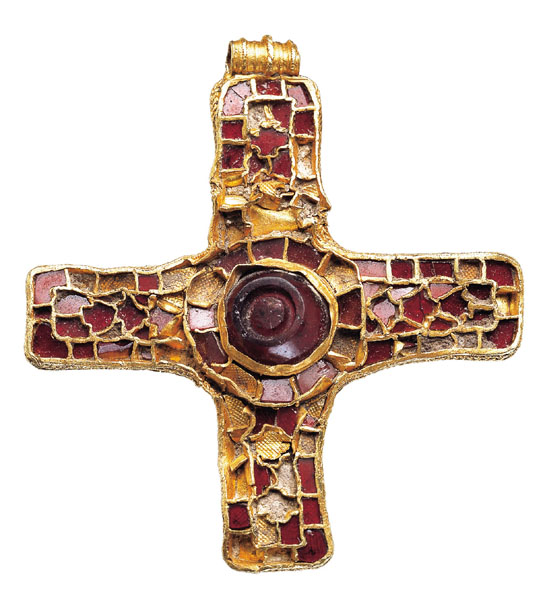Image: An Anglo-Saxon gold and garnet pectoral cross (FindID 28631)
Description: Anglo-Saxon pectoral cross pendant made from gold cloisonné work inlaid with garnets. 58 of the 95 original garnets now remain, and through X-ray diffraction it has been shown that the garnets are sited on a bed of calcium carbonate; this is a common technique in Anglo-Saxon jewellery manufacture. It is likely to date from the first half of the 7th century (see below) and is thus a very early example of a pectoral cross. Angela Care-Evans contributed the following report: Description: The cross is equal-armed, each arm with rounded corners and with cloisonné cell-work of gold built up on a thin backplate. The cell-work is filled with poorly shaped garnets over a calcium carbonate backing paste. At the centre of the cross is a large flattened cabochon-cut garnet whose upper surface is drilled with a circle, probably for the insertion of a gold or blue glass fillet, now missing. The cabochon is set in a simple cell with a collar of undecorated gold strip, and is surrounded by a ring of twelve square or rectangular garnets (three now missing) set over pointillé gold foil. The four arms of the cross spring from this central field and are filled with garnets. Within a simple border of roughly square garnets, the arms share paired motifs: the upper and lower arms are decorated with a central panel containing two cruciform stones surrounded by small garnets cut to accommodate them, and the lateral arms contain a panel filled with very poorly made pointed mushroom/arrow-shaped garnets, again with small garnets cut to fill the panel's margins. The cross is suspended by a heavy gold suspension loop soldered to the backplate and decorated with fine filigree wire, and a double strand of twisted wire (SZ) runs around the edge of the cross disguising the join between the cellwork and backplate. The cross is battered and the arm ending in the suspension loop has been bent and straightened out, causing the cell-work to buckle. Dimensions: Height: 53 mm; width: 50 mm; metal analysis: 77% gold, 22% silver; weight: 12.23g. Discussion: Cross pendants are rare in the early Christian period, but the Holderness example can be usefully compared to three other gold examples which share cloisonné garnet inlays (Webster and Backhouse (eds) 1991, cat. nos. 11, 12 and 98). Two, the Ixworth cross (cat. no. 11, p. 26) and the Wilton cross (cat. no. 12, p. 27), are similarly made to the Holderness cross, and have finely executed cloisonné garnet-filled cellwork soldered to a simple backplate. The cell shapes are varied and sophisticated. Both the Wilton and Ixworth crosses have flaring arms that spring from a central medallion, and both date from the early 7th century. The third, St Cuthbert's cross (cat. 98, p. 133), also has flaring arms but these, in contrast to the Ixworth and Wilton crosses, are filled with simple square-cut garnets, and spring from a single large plate garnet in a shell collar at the centre. The structure of St Cuthbert's cross is more complex than the other two, and relates to the later composite brooches rather than to the earlier 7th century pendant crosses. It was found in the coffin of the saint and was made during the second half of the 7th century. The Holderness cross has manufacturing techniques in common with both the Ixworth and Wilton crosses. It also shares the use of a border filled with simple square or rectangular garnets with the Ixworth cross and the arrow-shaped garnet with the Wilton cross, where it is used as a filler element to a paired mushroom shaped cell - a motif in Anglo-Saxon England which is characteristic of the early 7th century. On balance, the Holderness cross relates more closely to metalwork made in the early 7th century. Published in the Treasure Annual Report 1997-98, no. 80. Declared not treasure trove in April 1999 and returned to finder. This is now known as the Holderness Cross and was acquired by the Ashmolean Museum. Update: In 2011 a fourth gold-and-garnet cross was excavated by the Cambridge Archaeological Unit at Trumpington in Cambridgeshire. This again has the border of small square garnets, as at Holderness, Ixworth and Wilton. The Trumpington cross shares the flared arms and circular centre of the Ixworth and Wilton crosses, and the arms are filled with gold granules surrounded by collars of beaded wire. It was stitched onto the garment via loops rather than being suspended on a necklace. The Trumpington cross was found in the grave of a teenage girl who had been laid on a bed, a similar context to the Ixworth cross. In Webster and Backhouse (eds) 1991, the Ixworth cross (no. 11) is dated to the mid 7th century. The Wilton cross (no. 12) contains a coin of Heraclius (613-630) and therefore cannot be any earlier than this; Angela Evans suggests a date in the 630s would be appropriate. With this in mind, it seems likely that both the Trumpington and the Holderness crosses should be dated similarly to the mid 7th century, approximately perhaps 620-660 AD.
Title: An Anglo-Saxon gold and garnet pectoral cross
Credit: https://finds.org.uk/database/ajax/download/id/320120 Catalog: https://finds.org.uk/database/images/image/id/320120/recordtype/artefacts archive copy Artefact: https://finds.org.uk/database/artefacts/record/id/28631
Author: All rights reserved, Daniel Pett, 2011-03-10 15:05:07
Permission: Attribution-ShareAlike License
Usage Terms: Creative Commons Attribution-Share Alike 2.0
License: CC BY-SA 2.0
License Link: https://creativecommons.org/licenses/by-sa/2.0
Attribution Required?: Yes
Image usage
The following page links to this image:


